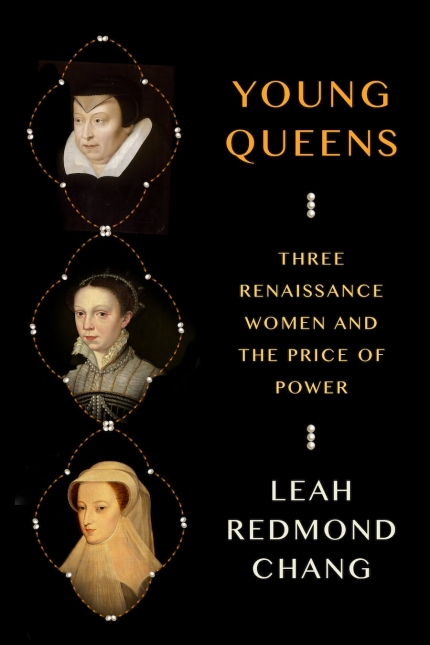Young Queens: Three Renaissance Women and the Price of Power
- By Leah Redmond Chang
- Farrar, Straus and Giroux
- 512 pp.
- Reviewed by Allison Thurman
- September 14, 2023
An absorbing look at how a trio of monarchs asserted influence.

The reigns and personalities of Catherine de Medici, Mary, Queen of Scots, and (to a lesser extent) Elisabeth de Valois, Catherine’s eldest daughter, are often considered in isolation from one another. However, for a brief time in the mid-16th century, all three women lived in the court of France: Catherine as queen of France, Elisabeth before her marriage to Philip II of Spain, and Mary in exile from Scotland and married to Catherine’s son Francis (later Francis II of France). In Young Queens, Leah Redmond Chang traces their histories, both apart and intertwined, and makes a good case that while differing personalities and circumstances informed their reigns, their common experiences as women had an outsized influence on their successes and failures.
Catherine was never intended to become queen. Daughter of the Medici heir and a French noblewoman, she was orphaned at an early age and was raised by relatives with the support of her uncle Pope Clement VII. After the Sack of Rome in 1527, she was imprisoned by Clement’s political opponents in a series of convents, where paradoxically she found “a measure of tranquility.” When Clement was restored to power, he arranged a marriage for Catherine to the second son of Francis I of France — quite a triumph for a girl who, while wealthy, was still only a commoner.
By contrast, Mary became the queen of Scotland upon her father’s death when she was only 9 days old. Sent to the French court for her safety, she was raised with Catherine’s children and betrothed early to Francis. Trained by her Guise relatives from childhood to promote their interests, Mary was “blue-eyed, pink-cheeked, and silver-tongued,” at once confident of her status yet accustomed to being led. She was better prepared to be a consort than a ruler in her own right.
Such was Mary’s charisma that she overshadowed one of her closest playmates in the French royal nursery, Elisabeth. While the Guises put Mary in the spotlight from an early age, Catherine held Elisabeth close until she was older, so we have little idea of her childhood personality. Chang speculates that she was “stubborn [and] somewhat impish,” largely based on Mary’s surviving letters to her. As children, Elisabeth trailed behind her elder “sister,” but as adults, their positions would switch dramatically.
Based on surviving correspondence and contemporary observations, the three women shared bonds of affection and respect, but the negotiation of politics and status inevitably crept into their relationships. Chang acknowledges that we cannot know everything, for many of their interactions were not written down, and even letters lack what was said by the messengers who delivered them.
The sudden death of France’s Henry II (Elisabeth’s father) in a jousting accident in 1559 changed their lives and relationships. Catherine went from queen consort to queen in all but name as she became the power behind the throne for the teenage Francis II. Elisabeth departed soon after the funeral to marry Philip II of Spain. Mary, wife of the teenage king, became queen of France — and soon after, a dowager queen herself at 17. It’s in the recounting of these shifting alliances that Chang’s narrative truly shines.
Each woman inherited different social and political challenges. Catherine had to placate her Spanish allies by responding to Protestant resistance to royal power while avoiding a civil war between French Huguenot and Catholic factions. Elisabeth was expected to embrace Spanish identity and causes as a good wife while (subtly, with deference) fielding Catherine’s requests for French political favors. Both Catherine and Elisabeth distanced themselves from Mary, who alienated them with her simultaneous efforts to ingratiate herself with Catholic Spain while also pressing her right to the throne of Protestant England, complicating an already fragile network of alliances.
A complicating factor was the women’s need to exercise power through the men in their lives. Elisabeth of Valois receives the least attention when discussing these machinations, probably because, as the shortest lived (she died at 22), she had the least opportunity to influence Philip II. Though often condemned by opponents as “dissimulative and manipulative,” Catherine did her best to steer France through the early years of two of her sons’ reigns during a time of religious upheaval. By contrast, Mary’s suspected involvement in the death of one husband, followed by the decision (even if coerced) to marry one of his murderers, undermined her authority to the point that she was forced to abdicate.
Chang does an excellent job describing the concerns of continental Europe through the personal relationships of her three subjects. She also emphasizes their commonalities: Ultimately, early modern queens’ successes and failures were informed by their ability to fulfill the traditional roles of wife and mother. Both Catherine and Elisabeth saw their authority limited until they bore heirs; much of Catherine’s status in her later years, in fact, came from being the mother of kings. Meanwhile, Mary’s inclination to defer to her rather poor choices of husband meant that although she was born to rule, she was eventually vanquished — executed by her cousin Elizabeth I, a woman who chose not to play by the rules.
Young Queens is a nuanced, intriguing overview not only of the interactions among three monarchs but also among three women. All had places of power unusual for 16th-century wives and daughters, yet all were also subject to the often unreasonable expectations and limits imposed upon women — royal or otherwise — at the time.
Allison Thurman has a longstanding interest in 16th-century history and is currently editing her first novel, about the Elizabethan medium Edward Kelley. She lives in Gaithersburg, MD, with too many books and not enough swords.

